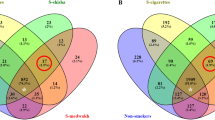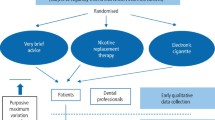Key Points
-
Smoking is a major public health problem in the UK.
-
Evidence-based guidelines provide clear guidance to health professionals on effective ways of helping patients to stop smoking.
-
Dentists and their teams have an opportunity to become involved in smoking cessation activities.
-
A range of public health measures are also required to support clinician's efforts against smoking.
Abstract
In 1998, the UK government published a White Paper outlining a comprehensive range of measures to reduce smoking rates across the population. In the same year a detailed overview of the evidence base for smoking cessation activities within the NHS was published. Both these documents provide useful information for health professionals interested in developing their roles in smoking cessation and prevention. An increased risk for the development of oral malignacies and a susceptibility for the breakdown of periodontal tissues are the most significant effects of smoking on the mouth. This paper aims to highlight how dentists and their team members can become actively involved in efforts to reduce smoking. Opportunities at both a clinical and public health level are considered.
Similar content being viewed by others
Log in or create a free account to read this content
Gain free access to this article, as well as selected content from this journal and more on nature.com
or
References
Callum C . The UK smoking epidemic: Deaths in 1995. London: Health Education Authority, 1998.
Smoking Kills: A White Paper on Tobacco. London: The Stationery Office, 1998.
Thomas M, Walker A, Wilmot A, Bennet N . Office for National Statistics. Living in Britain: results from the 1996 General Household Survey. London: The Stationery Office, 1998.
Jarvis L . Smoking among secondary school children in 1996: England. Office of National Statistics. London: The Stationery Office, 1997.
Saving Lives: Our Healthier Nation. London: The Stationery Office, 1999.
Legarth J, Reibel J . EU Working Group on Tobacco and Oral Health. Oral Dis 1998; 4: 48–67.
Johnson N W, Bain C . Tobacco and oral disease. Br Dent J 2000; 4: 200–206.
Cancer Research Campaign. Cancersheet; Oral Cancer — UK. London: Cancer Research Campaign, 2000.
Franco E, Kowalski L, Oliveria B et al. Risk factors for oral cancer in Brazil: a case control study. Int J Cancer 1989; 43: 992–1000.
Owen L, Bolling K . Tracking teenage smoking. London: Health Education Authority, 1995.
Raw M, McNeill A, West R . Smoking cessation guidelines for health professionals. A guide to effective smoking cessation interventions for the health care system. Thorax 1998; Suppl. 5: 1–38.
Cohen S J, Stookey G K, Katz B P, Drook C A, Christen A G . Helping smokers quit: a randomised controlled trial with private practice dentists. JADA 1989; 118: 41–45.
Smith S E, Warnakulasuriya K A A S, Feyerabend C, Belcher M, Cooper D J, Johnson N W . A smoking cessation programme conducted through dental practices in the UK. Br Dent J 1998; 185: 299–303.
John J H, Yudkin P, Murphy M, Ziebland S, Fowler G H . Smoking cessation interventions for dental patients-attitudes and practices of dentists in the Oxford region. Br Dent J 1997; 183: 359–364.
McCann M, Macpherson L M D, Binnie V . et al. A survey of Scottish primary care dental practitioners' oral cancer-related practices and training requirements. Com Dent Health 2000; 17: 24–30.
Chestnutt I G, Binnie V I . Smoking cessation counselling-a role for the dental profession? Br Dent J 1995; 179: 411–415.
Warnakulasuriya K A A S, Johnson N W . Dentists and oral cancer prevention in the UK: opinions, attitudes and practices of screening for mucosal lesions and to counselling patients on tobacco and alcohol use: baseline data from 1991. Oral Dis 1999; 5: 10–14.
Allard R H B . Tobacco and oral health: attitudes and opinions of EU dentists; a report of the EU working group on tobacco and oral health. Int Dent J 2000; 50: 99–102.
Watt R, Robinson M . Helping smokers to stop – a guide for the dental team. London: Health Education Authority, 1999.
Glynn T J, Manley M W . How to help your patients stop smoking. A National Cancer Institute Manual for Physicians. Washington: US Department of Health and Human Services, 1989.
Warnakulasuriya K, Harris C, Scarrott D . et al. An alarming lack of public awareness towards oral cancer. Br Dent J 1999; 187: 319–322.
Prochaska J O, Goldstein M G . Process of smoking cessation: Implications for clinicians. Clin Chest Med 1991; 42: 727–775.
Sprod A, Anderson R, Treasure E . Effective oral health promotion. Literature review. Technical report no. 20 Cardiff: Health Promotion Wales, 1996.
Acknowledgements
The authors are grateful to Dr Ann McNeill at the Health Education Authority for her helpful comments on this manuscript.
Author information
Authors and Affiliations
Corresponding author
Additional information
Refereed Paper
Rights and permissions
About this article
Cite this article
Watt, R., Johnson, N. & Warnakulasuriya, K. Action on smoking — opportunities for the dental team. Br Dent J 189, 357–360 (2000). https://doi.org/10.1038/sj.bdj.4800768
Received:
Accepted:
Published:
Issue date:
DOI: https://doi.org/10.1038/sj.bdj.4800768



